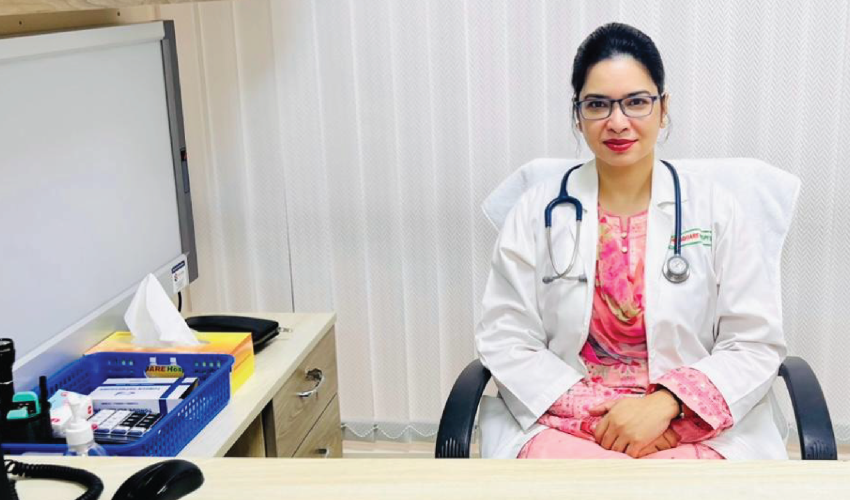Expert insights for awareness and early detection
By Ayman Anika
For countless individuals and families, breast cancer represents more than just a medical diagnosis – it’s a deeply personal battle that touches the core of our lives. Millions of women worldwide face this challenge each year, a journey filled with emotional highs and lows, hope, and resilience. Despite its prevalence, there are still many misconceptions and a lack of knowledge about breast cancer that can hinder effective prevention, diagnosis, and treatment.
We talked to Dr Fariah Sharmeen, an Associate Consultant at the Oncology and Radiology Department, Square Hospital Ltd., who shared her insights into this complex disease.
Recognizing the signs of breast cancer
Recognizing the early signs of breast cancer is key to prompt diagnosis and treatment. Dr Sharmeen emphasizes the importance of being vigilant about changes in one’s body. “The most common symptom of breast cancer is the appearance of a new lump or mass in the breast,” she explains. “While most breast lumps are benign, it’s critical to understand that about 10 per cent are cancerous.”
Dr Sharmeen details that these lumps are usually painless, which might lead someone to underestimate their significance. “In about 2-5 per cent of cases, these lumps can be painful. Typically, cancerous lumps are hard and may have irregular edges, though they can also be soft and rounded,” she adds.
Further symptoms as outlined by Dr Sharmeen include:
Swelling of all or part of a breast, which can occur even if no distinct lump is felt.
Skin changes may also appear, including dimpling or puckering, sometimes looking akin to an orange peel. In addition, nipple changes might become equally visible. This could be a retraction of the nipple or an inward turn.
Also, look for changes in skin texture such as red, dry, flaking, or thickened skin on the nipple or the broader breast area – this is a sign to watch for.
Moreover, changes in the size or shape of breasts may happen. You might notice an unexplained change in the size or shape of the breast – one breast may start to feel noticeably heavier.
Persistent pain is another clear sign. You might experience continuous pain in the breast or armpit area, not tied to menstrual cycles.
Furthermore, you could feel lumps near the collarbone or underarm. These could indicate that breast cancer has spread to lymph nodes in these areas, even before the primary tumor becomes palpable.
Dr Sharmeen advises, “If you notice any of these changes, it’s vital to seek professional evaluation. Although these symptoms can be linked to conditions other than cancer, ruling out breast cancer is essential. Early detection significantly enhances treatment effectiveness.”
SCREENING AND EARLY DETECTION
Screening is a powerful tool for detecting breast cancer early before symptoms even arise. The general guidelines suggest that women should begin breast cancer screening from the age of 40 onwards, with annual or biennial mammograms. However, the frequency and starting age can vary based on individual risk factors.
Dr Sharmeen outlines the various screening methods including clinical breast examinations, self-breast examinations, mammograms, ultrasonography, and MRI. “The American College of Radiology recommends that women start screening at the age of 40, with yearly mammograms and clinical breast examinations,” she notes.
For women between 55 and 74, mammograms can be done every two years, though annual screenings are still advised for those who prefer it. Women over 75 should continue screening as long as they are in good health and have a life expectancy of at least 10 years.
That said, women with a family history of breast cancer or genetic predisposition may need to start screening earlier and might also benefit from additional MRI scans. Discussing personal risk factors with a healthcare provider can ensure a screening schedule that aligns with one’s specific needs.
THE ROLE OF GENETICS IN BREAST CANCER
Genetics can play a decisive role in understanding an individual’s risk of developing breast cancer. Dr Sharmeen explains, “While lifestyle and environmental factors contribute to many cases of breast cancer, a significant portion is influenced by genetic predisposition.”
“About 10 per cent of breast cancer cases are considered hereditary, meaning they result directly from gene defects passed down from one’s parents,” she adds.
The most well-known genetic mutations associated with increased breast cancer risk are found in the BRCA1 and BRCA2 genes. Carrying mutations in these genes not only elevates the risk of developing breast and ovarian cancers but also affects the age at which these cancers may occur.
“Individuals with a BRCA1 mutation can have a lifetime breast cancer risk as high as 85% and a significant risk for ovarian cancer as well. BRCA2 mutations share similar breast cancer risks but have a somewhat lower risk for ovarian cancer,” Dr Sharmeen elaborates.
According to Dr Sharmeen, understanding a person’s genetic makeup can provide important information not just for the individual but for their family members as well. If a mutation is identified, other family members may also choose to undergo genetic testing to determine their own risk levels and By Ayman Anika make informed decisions about their health.
Therefore, in the fight against breast cancer, analyzing the role of genetics is vital. It allows for tailored interventions and helps raise awareness about the importance of genetic factors in the broader landscape of cancer care and prevention.
Research continues to yield promising advances in breast cancer treatment. “Novel treatments such as Antibody-drug conjugates, targeted drugs like CDK 4,6 inhibitors, and advances in gene therapy are changing the landscape of cancer treatment,” details Dr Sharmeen.
These advancements aim to target cancer cells more precisely, reducing side effects and improving patient outcomes.
PSYCHOLOGICAL IMPACT AND SUPPORT IN BREAST CANCER
The diagnosis of breast cancer often carries with it not just physical challenges but profound psychological and emotional repercussions as well.
“Upon diagnosis, patients may experience a whirlwind of emotions – fear, anger, helplessness, and disbelief are common,” Dr Sharmeen explains. The uncertainty about the future, concerns about physical appearance, and the effects of treatment can lead to significant stress and anxiety. “It’s natural for emotions to fluctuate dramatically, and each person’s reaction can be quite different,” she adds.
Depression is also a frequent companion of breast cancer patients. The ongoing stress of dealing with cancer, coupled with the physical toll of treatments, can exacerbate these feelings. Dr Sharmeen notes, “Being vigilant about symptoms of depression is crucial, as it can affect the patient’s motivation to continue treatment and impact their overall quality of life.”
Breast cancer treatment can involve surgeries that alter a woman’s body, such as mastectomies or lumpectomies, which can significantly impact body image and self-esteem.
“Many women struggle with the changes to their bodies and this can affect their self-image and sexuality,” Dr Sharmeen points out. Support from healthcare providers in managing these changes, including counselling and access to reconstructive surgery, can play a vital role in recovery.
Moreover, the end of cancer treatment does not necessarily mean the end of psychological challenges. Fear of recurrence is common and can linger long after treatment has ended.
“Long-term follow-up with a psychological care provider can help address ongoing or new mental health issues,” Dr Sharmeen recommends. This continued support is crucial for sustaining mental health and ensuring any long-term emotional issues are addressed promptly.
Of course, breast cancer is a complex disease – with each case presenting unique challenges and requiring personalized treatment strategies. Awareness and education about the signs, screenings, genetic aspects, and new treatments can empower women and their communities to manage this health challenge more effectively.
Hence, as we continue to advance in our understanding and technology, there is hopeful anticipation that the battle against breast cancer will be increasingly effective, offering brighter prospects for those affected. Engaging with this topic not only during awareness months but throughout the year is essential for fostering a society more informed and supportive in the face of breast cancer.













